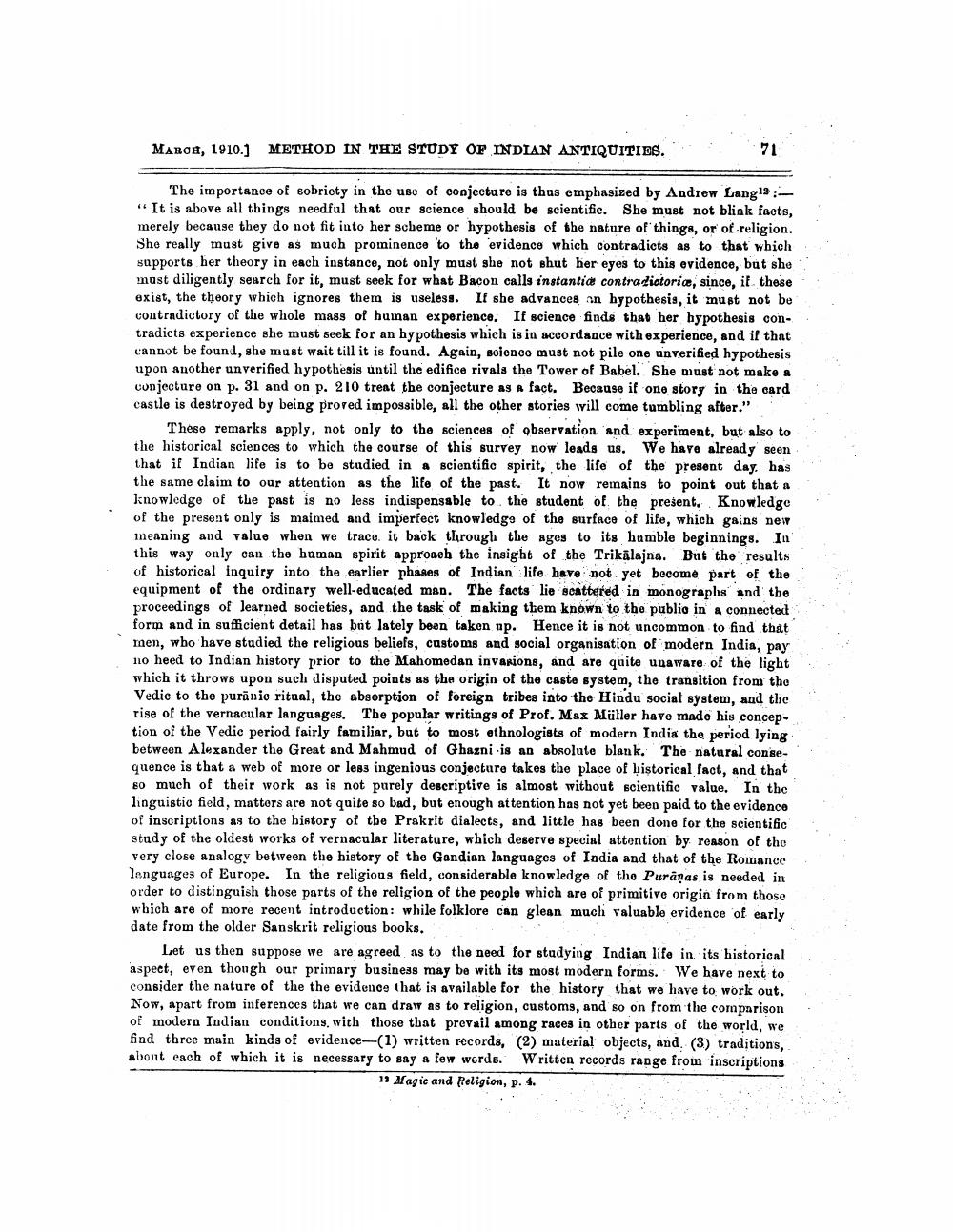________________
MAROA, 1910.) METHOD IN THE STUDY OF INDIAN ANTIQUITIES.
The importance of sobriety in the use of conjecture is thus emphasized by Andrew Lang 12 - " It is above all things needful that our science should be scientific. She must not blink facts, merely because they do not fit into her scheme or hypothesis of the nature of things, or of religion. She really must give as much prominence to the evidence which contradicts as to that which supports her theory in each instance, not only must she not shut her eyes to this evidence, but she must diligently search for it, must seek for what Bacon calls instantia contradictorice, since, it these exist, the theory which ignores them is useless. If she advances an hypothesis, it must not be contrdictory of the whole mass of human experience. If science finds that her hypothesis contradicts experience she must seek for an hypothesis which is in accordance with experience, and if that cannot be found, she must wait till it is found. Again, science must not pile one unverified hypothesis upon another unverified hypothesis until the edifice rivals the Tower of Babel. She must not make a conjecture on p. 31 and on p. 210 treat the conjecture as a fact. Because if one story in the card castle is destroyed by being proved impossible, all the other stories will come tumbling after."
These remarks apply, not only to the sciences of observation and experiment, but also to the historical sciences to which the course of this survey now leads us. We have already seen that if Indian life is to be studied in a scientific spirit, the life of the present day. has the same claim to our attention as the life of the past. It now remains to point out that a knowledge of the past is no less indispensable to the student of the present. Knowledge of the present only is maimed and imperfect knowledge of the surface of life, which gains new meaning and value when we trace. it back through the ages to its hamble beginnings. In this way only can the human spirit approach the insight of the Trikālajna. But the results of historical inquiry into the earlier phases of Indian life have not yet become part of the equipment of the ordinary well-educated man. The facts lie scattered in monographs and the proceedings of learned societies, and the task of making them known to the publio in a connected form and in sufficient detail has buit lately been taken up. Hence it is not uncommon to find that men, who have studied the religious beliefs, customs and social organisation of modern India, pay 110 heed to Indian history prior to the Mahomedan invasions, and are quite unaware of the light which it throws upon such disputed points as the origin of the caste system, the transition from the Vedic to the purānic ritual, the absorption of foreign tribes into the Hindu social system, and the rise of the vernacular languages. The popular writings of Prof. Max Müller have made his conception of the Vedic period fairly familiar, but to most ethnologists of modern India the period lying between Alexander the Great and Mahmud of Ghazni is an absolute blank. The natural consequence is that a web of more or less ingenious conjecture takes the place of bistorical fact, and that 80 much of their work as is not purely descriptive is almost without scientific value. In the linguistio field, matters are not quite so bad, but enough attention has not yet been paid to the evidence of inscriptions as to the bistory of the Prakrit dialects, and little has been done for the scientific study of the oldest works of vernacular literature, which deserve special attention by reason of tho very close analogy between the history of the Gandian languages of India and that of the Romance lenguages of Europe. In the religious field, considerable knowledge of the Puranas is needed in order to distinguish those parts of the religion of the people which are of primitive origin from those wbich are of more recent introduction: while folklore can glean much valuable evidence of early date from the older Sanskrit religious books.
Let us then suppose we are agreed as to the need for studying Indian life in its historical aspect, even thongh our primary business may be with its most modern forms. We have next to consider the nature of the the evidence that is available for the history that we have to work out. Now, apart from inferences that we can draw as to religion, customs, and so on from the comparison of modern Indian conditions, with those that prevail among races in other parts of the world, we find three main kinds of evidence-(1) written records, (2) material objects, and (3) traditions, about each of which it is necessary to say a few words. Written records range from inscriptions
11 Magic and Religion, p. 4.




